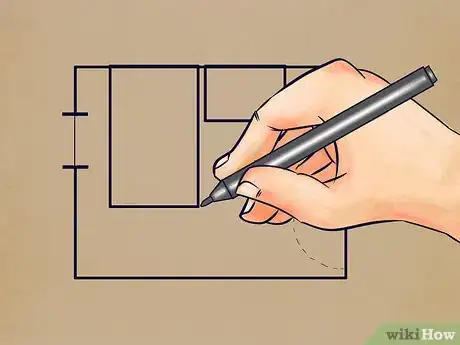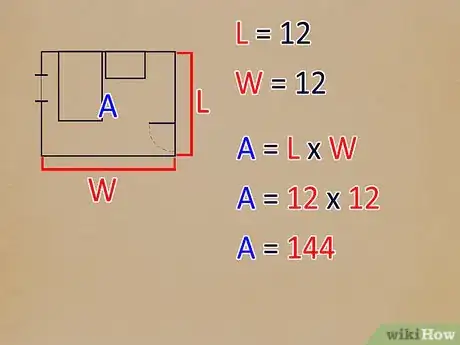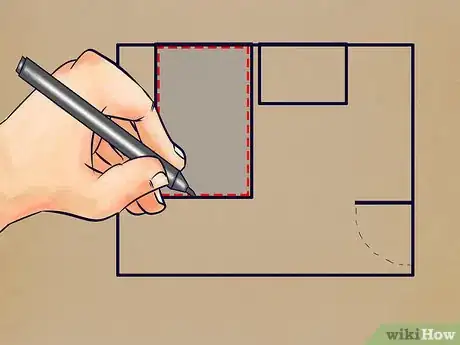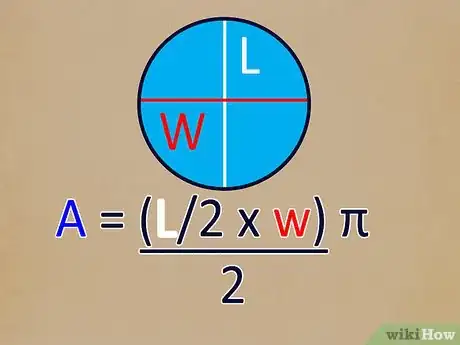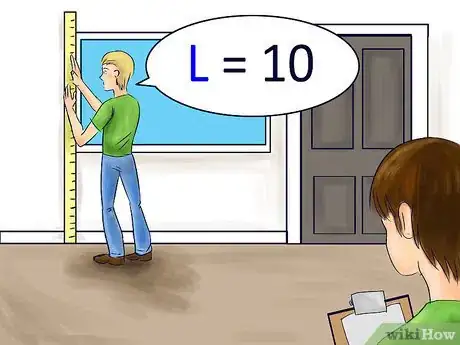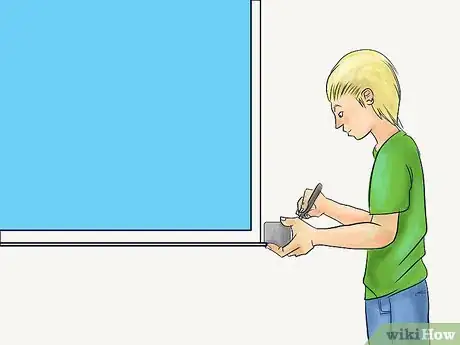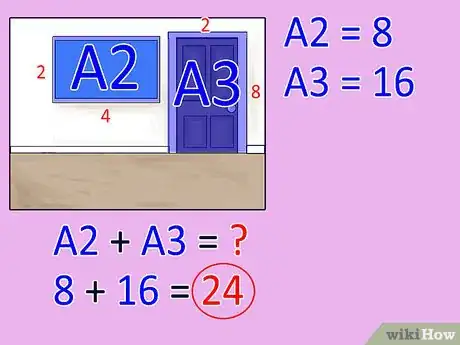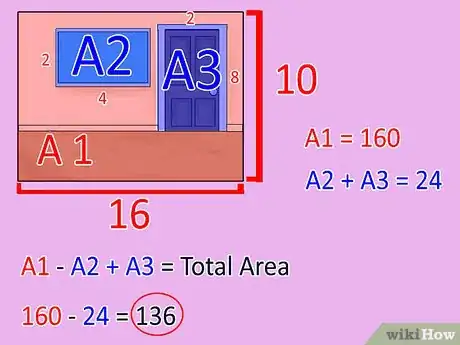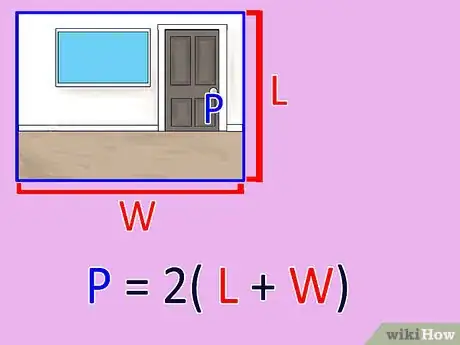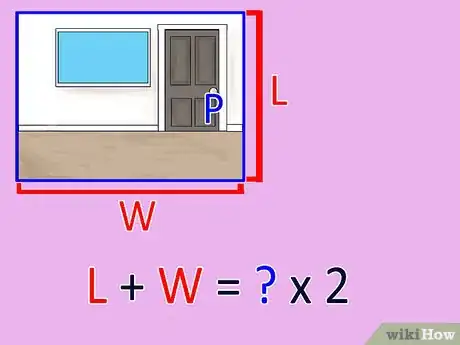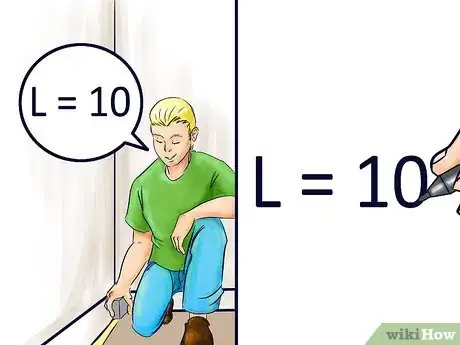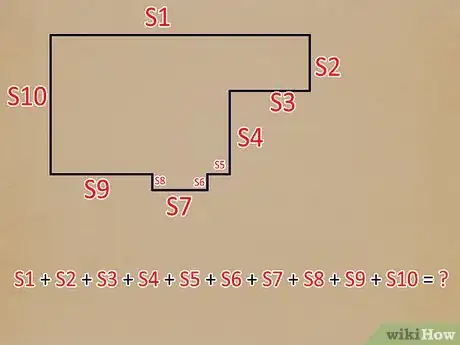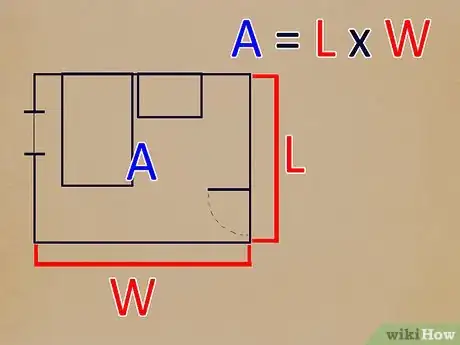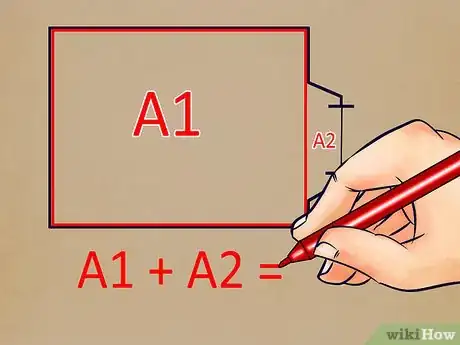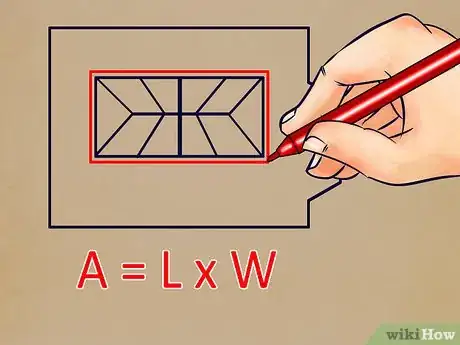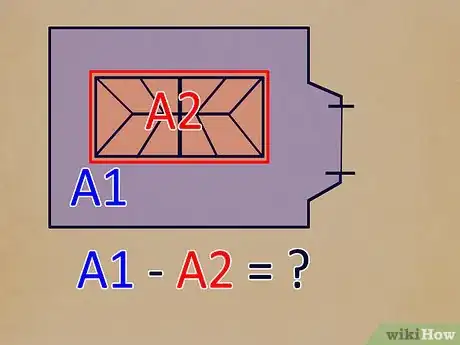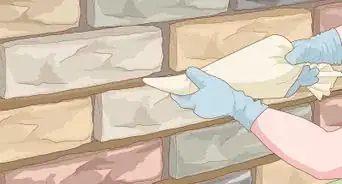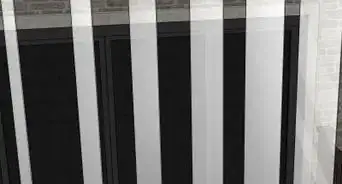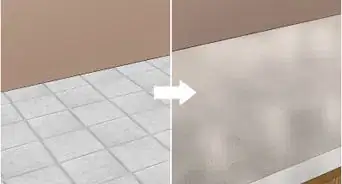wikiHow is a “wiki,” similar to Wikipedia, which means that many of our articles are co-written by multiple authors. To create this article, 42 people, some anonymous, worked to edit and improve it over time.
This article has been viewed 623,388 times.
Learn more...
Knowing how to accurately measure a room will help with many home improvement projects, such as flooring and painting. Depending on the reason that you are measuring the room, different measurements need to be taken. For example, if you're putting in flooring, you need to know the area of the floor. If you are painting, you need to know the area of the walls and ceiling, and so on. This can be difficult if you've never done it before, and can be complicated by built-in features like sloping ceilings, recesses, and bay windows.
Steps
Measuring Floors
-
1Make a drawing of the floor plan in the room you are measuring. You will use this drawing to record your measurements. The drawing does not have to be to scale, but the more accurate it is, the more useful it'll be.
- Since you are just measuring floors, including windows and doorways should not matter.
- Include all areas involved in your project. For example, if you’re putting in flooring and have a walk-in closet you are also flooring, draw the closet.
- In this hypothetical drawing, there is a bathroom on the right (which is a separate room, so it is not drawn) and a bay window to the left (shown with a half circle).
-
2Measure the length and width of the room’s main area. To calculate the area of a room, use the standard (Length) x (Width) = Area formula.[1] Measure the maximum length and width at the widest points of the room. This is important and will help you get the correct measurements.
- Move any items or furniture in the way of your measuring tape.
- Having a friend hold the end of the tape could help.
- Right now, you are only measuring the main area. Ignore bay windows and separate areas like bathrooms for this step.
Advertisement -
3Multiply the length and the width to get the main area’s measurement. Use a calculator to ensure this measurement is accurate. For instance, if the room is 12 feet wide and 12 feet long, the area of the floor is 144 square feet. Your result is the measurement of the total floor area. Record this number on your drawing.
-
4Measure the length and width of any square or rectangular recesses. These often include closets or bathrooms that you are part of a flooring or tile project. Measuring square or rectangular recesses is the same as measuring the main area of the room. Measure the width and length of the recess, then multiply the length and width to find the area of the recess.
- Write down the result in the recess area of your drawing.
- Repeat this step if there are multiple recesses in the room.
-
5Calculate the area of any round recesses. Measure the longest length (usually through the center) and width of the recess.[2] Do not measure further than the edge of the main area you already measured. Next, divide the length by two. Then, multiply this number by the width. Now, multiply the total by pi (3.14). Lastly, divide the area in half.
- Record the number in the recess area of your drawing.
- Now you have the area of the U-shaped protrusion in the room.
- The area in a bay window recess should only be included as part of the area of the room if it has a floor (rather than a seat) and the ceiling is at least seven feet or 2.13 m high.
-
6Add all of the areas together to get the total floor area. Add the areas of all recesses to the main floor area. Now, you have the total square footage of your floor, and you can purchase carpet, flooring, or other materials accordingly.
Measuring Walls
-
1Make a drawing of all walls you need to measure. Include doors and windows in your drawing as well. Leave enough room in the drawing to write down measurements.
-
2Measure the width and height of the wall. To calculate the area of a wall, use the standard (Width) x (Height) = Area formula.[3] Using a measuring tape, measure the width and height of the wall. Since walls can be tall, you might want to ask a friend or neighbor for help holding the measuring tape. Record the measurements on your drawing.
-
3Multiply the length and width together. Using a calculator, multiply the length and width. This will equal the total square footage of the wall. Write this number down.
-
4Measure the length and width of any doors, fixtures, or windows. Record the length and width of any doors or windows on your drawing.
-
5Multiply the length and width of any doors, fixtures, or windows. Use a calculator to multiply the length and width of any doors or windows present. Record each individual total. These measurements indicate the square footage of any doors, windows, or fixtures.
-
6Add the total areas of any doors, fixtures, or windows. This only applies to walls that have more than one door, fixture, or window. Write this number down.
-
7Subtract the total from step six from the total wall square footage. Use a calculator for this step, too. This number equals the square footage of the wall, and you can use this square footage to buy paint or wallpaper.
Measuring a Room’s Perimeter
-
1Measure the length and the width of a square or rectangular room. Use the standard 2(Length + Width) = Perimeter formula to find the perimeter of a room.[4] Using a measuring tape, find the length and width of the room.
-
2Add the length and the width, then multiply the answer by two. Use a calculator to make sure your addition and multiplication is accurate. Once you add the length and the width, multiply that total by two. This will calculate the perimeter of the room.
-
3Measure an irregularly shaped room manually. If the room you are measuring is not a square or rectangular, you will need to measure each individual side of the room’s perimeter. Work your way around the room’s perimeter with a measuring tape, recording the length of each side of the room.
-
4Add all the measurements together. Use a calculator to add up every measurement you took of the irregularly shaped room. The result of this calculation is the length of the perimeter of the room.
Measuring Ceilings
-
1Calculate the floor area. This is described in method one. If the ceiling is flat, by calculating the floor area, you now have your ceiling area as well. For rectangular and square rooms with flat ceilings, the area of the floor is the same as the ceiling’s area.[5] If you have any extra parts of the ceiling that stick out or cave in, continue on to step two.
-
2Measure any additions to the ceiling area separately. This step only applies to ceilings that are not flat. Many ceilings also have alcoves and window bays that stick out; measure the width and depth of any alcoves or window bays.[6] Record all measurements.
- A ceiling that slopes or has recesses or variation of any kind will have a larger surface area than the floor, so keep that in mind when buying materials (i.e. buy a little extra).
- Ceilings can be difficult to reach. If you are measuring a ceiling, ask a friend for assistance.
- You will probably need a ladder to reach the ceiling for measurement.
-
3Add extra ceiling measurements to the area of the room. Add all additional measurements to the number calculated in step one. Write the total down.
-
4Measure the area of any skylights. If you don’t have skylights on the ceiling, skip this step. Ceilings sometimes have skylights, and the area of these must be subtracted from the total ceiling area calculated in step three. Measure the length and width of a skylight to get its area. Then, multiple the length and the width. Now, you have the area of the skylight.
-
5Subtract the area of the skylight from the ceiling area. Subtract the number calculated in step four from the total area of the ceiling. The result of this calculation is the square footage of your ceiling.
Community Q&A
-
QuestionWhat is the formula of area?
 Community AnswerFor a rectangle, it is length times breadth.
Community AnswerFor a rectangle, it is length times breadth. -
QuestionWhat is the difference between the area and perimeter of a room?
 Community AnswerArea is the sum of the length and width of a room, and perimeter is the total length of all the sides of the room added up.
Community AnswerArea is the sum of the length and width of a room, and perimeter is the total length of all the sides of the room added up. -
QuestionIs it okay to use a ruler for a floor plan?
 Community AnswerYes, but if you're using a 1-foot ruler, use a lot of patience or invest in a longer one if you're staying with the sticks. Or get a tape measure and use the 1-footer on smaller spaces.
Community AnswerYes, but if you're using a 1-foot ruler, use a lot of patience or invest in a longer one if you're staying with the sticks. Or get a tape measure and use the 1-footer on smaller spaces.
Things You Will Need
- Measuring tape
- Pencil
- Paper
- Calculator
- Ladder
References
- ↑ https://www.lowes.com/n/how-to/measure-a-room
- ↑ https://www.lowes.com/n/how-to/measure-a-room
- ↑ https://www.lowes.com/n/how-to/measure-a-room
- ↑ https://www.lowes.com/n/how-to/measure-a-room
- ↑ http://www.betterceilings.com/helpful-tools/how-to-measure
- ↑ http://www.betterceilings.com/helpful-tools/how-to-measure/
- ↑ https://www.lowes.com/n/how-to/measure-a-room
About This Article
To measure the floors of a room, measure the length and width of the room at the widest parts with a tape measure. Then, multiply these numbers together to find the area of the room in square feet. If there are any rectangular recesses in the room, like a closet or bathroom, repeat this process add everything together to determine the total floor area. To learn how to calculate round areas of a room, keep scrolling!
